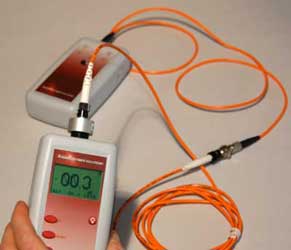Exploring the Benefits of Optical Fiber Evaluating for Enhanced Interaction Solutions
The significance of optical fiber screening in modern communication systems can not be overemphasized, as it serves as a structure for guaranteeing network integrity and efficiency. This proactive testing strategy has profound implications for signal quality and functional effectiveness, raising the concern of exactly how these techniques add to lasting sustainability in an ever-evolving technical landscape.
Significance of Optical Fiber Testing
The relevance of optical fibre screening can not be overstated in today's data-driven setting. As organizations significantly rely on high-speed information transmission for daily procedures, the integrity and efficiency of optical fiber networks are paramount. Evaluating makes certain that these networks can support the substantial amounts of information generated and transferred flawlessly, fostering reliable interaction and connectivity.
Optical fibre testing offers numerous important functions, including validating setup top quality, recognizing possible faults, and identifying overall system efficiency. Routine screening can stop expensive downtimes and solution disturbances, permitting companies to preserve functional continuity. It aids in conformity with sector criteria and laws, making certain that fiber optic installments fulfill called for requirements for safety and security and integrity.
Furthermore, screening can improve the durability of fiber optic systems. By proactively recognizing issues such as signal loss, attenuation, or connector failures, organizations can resolve troubles prior to they intensify, therefore expanding the life of their framework. In recap, optical fibre testing is not simply a technological need yet a calculated financial investment that improves network dependability, optimizes performance, and ultimately supports the growth and effectiveness of modern-day interaction systems.
Trick Testing Methods

OTDR is an essential method made use of to recognize faults, step splice losses, and assess the total stability of a fibre optic web link. By sending out a pulse of light down the fibre and examining the shown light, specialists can determine locations of mistakes and assess the network's performance over lengthy ranges.
Insertion loss testing determines the quantity of signal loss that happens when light go through a link or splice. This method is critical for confirming that links meet given loss thresholds, which is necessary for maintaining optimum performance in interaction systems.
Optical return loss testing evaluates the quantity of light mirrored back towards the resource due to get redirected here flaws in the fiber or connections. High return loss worths show far better performance and minimized signal degradation.
Together, these testing approaches provide an extensive evaluation of fiber optic networks, guaranteeing their integrity and capability in varied interaction applications.
Effect On System Performance
Efficient optical fiber testing directly affects the total efficiency of communication systems. By guaranteeing the stability of fiber optic cables, testing determines prospective mistakes such as depletion, splice loss, and adapter misalignment. These issues can substantially degrade signal top quality, leading to interruptions and reduced data transmission rates.

Moreover, routine optical fiber testing adds to lasting system sustainability. It allows very early detection of deterioration, permitting timely maintenance and upgrades before significant failures take place. This not only prolongs the life-span of the facilities however also ensures that communication systems stay affordable in terms of performance.
Cost-Effectiveness and Performance
Cost-effectiveness is a critical consideration in the implementation and upkeep of optical fibre networks. Executing durable optical fiber testing procedures can dramatically reduce operational expenses by recognizing issues before they intensify right into major problems. ofda. By finding mistakes, attenuation, and other performance limitations early, companies can avoid costly repair services and downtime, which can disrupt services and result in profits loss
Additionally, effective testing techniques simplify the setup process, permitting professionals to work better. This converts to reduce labour expenses and faster project conclusion times. Advanced screening equipment, such as Optical Time Domain Name Reflectometers (OTDRs), allows a precise analysis of fibre high quality, ensuring that just optimal products are utilized, therefore lessening waste.
Regular screening likewise adds to much better source allowance. By understanding the network's efficiency, organizations can make enlightened decisions concerning upgrades and expansions, making certain that investments are dig this made where they are most required. In summary, optical fiber testing improves cost-effectiveness and efficiency, sustaining the long-term sustainability and competitiveness of communication systems in a progressively demanding market.
Making Certain Long-Term Dependability
Applying extensive optical fiber testing not just improves price savings and functional efficiency yet likewise plays a pivotal function in ensuring the long-lasting integrity of communication networks. Regular testing practices, consisting of depletion and data transfer analyses, help determine possible destruction in fibre performance prior to it leads Continued to solution interruptions.
By employing innovative testing approaches, network drivers can pinpoint faults or weak points in the fiber framework, permitting timely remediation. This positive approach minimizes downtime, making sure that interaction systems remain functional and effective. Regular testing contributes to the development of a more resilient network, as drivers can adjust and optimize their infrastructure based on real-time data insights.
Additionally, ensuring compliance with market requirements with optical fiber screening strengthens the top quality and honesty of the whole interaction system. This adherence not just strengthens self-confidence amongst stakeholders however likewise lines up with regulatory requirements, which are increasingly stringent.
Verdict
To conclude, optical fiber testing functions as a fundamental part in boosting interaction systems. By utilizing various screening approaches, such as OTDR and insertion loss evaluations, networks can accomplish optimal efficiency and dependability. The positive identification of faults not just enhances signal quality yet likewise reduces downtime, inevitably adding to cost-effectiveness and operational efficiency. Adherence to market criteria promotes stakeholder self-confidence, making sure the long-term sustainability of interaction infrastructures in a significantly data-driven landscape.